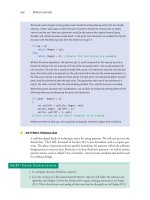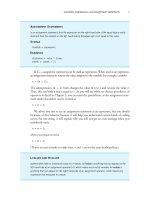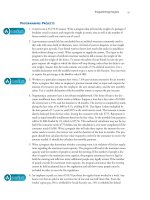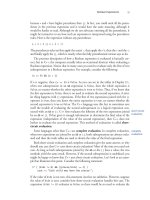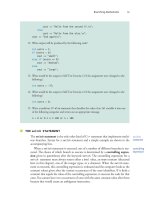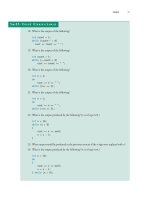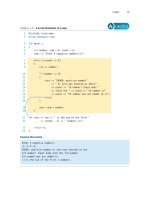Absolute C++ (4th Edition) part 44 pps
Bạn đang xem bản rút gọn của tài liệu. Xem và tải ngay bản đầy đủ của tài liệu tại đây (146.94 KB, 10 trang )
436 Pointers and Dynamic Arrays
class StringClass
{
public:
void someProcessing( );
StringClass& operator=(const StringClass& rtSide);
private:
char *a;//Dynamic array for characters in the string
int capacity;//size of dynamic array a
int length;//Number of characters in a
};
As noted in Chapter 8, when you overload the assignment operator it must be a
member of the class; it cannot be a friend of the class. That is why the above definition
has only one parameter for
operator. For example, consider the following:
s1 = s2;//s1 and s2 in the class StringClass
In the above call, s1 is the calling object and s2 is the argument to the member operator =.
The following definition of the overloaded assignment operator can be used in chains
of assignments like
s1 = s2 = s3;
and can be used to invoke member functions as follows:
(s1 = s2).someProcessing( );
The definition of the overloaded assignment operator uses the this pointer to return
the object on the left side of the
= sign (which is the calling object):
//This version does not work in all cases.
StringClass& StringClass::operator=(const StringClass& rtSide)
{
capacity = rtSide.capacity;
length = rtSide.length;
delete [] a;
a = new char[capacity];
for (int i = 0; i < length; i++)
a[i] = rtSide.a[i];
return *this;
}
This version has a problem when used in an assignment with the same object on
both sides of the assignment operator, like the following:
s = s;
= must be a
member
calling object
for
=
Classes, Pointers, and Dynamic Arrays 437
Example
When this assignment is executed, the following statement is executed:
delete [] a;
But the calling object is s, so this means
delete [] s.a;
The pointer s.a is then undefined. The assignment operator has corrupted the object s
and this run of the program is probably ruined.
For many classes, the obvious definition for overloading the assignment operator
does not work correctly when the same object is on both sides of the assignment opera-
tor. You should always check this case and be careful to write your definition of the
overloaded assignment operator so that it also works in this case.
To avoid the problem we had with our first definition of the overloaded assignment
operator, you can use the
this pointer to test this special case as follows:
//Final version with bug fixed:
StringClass& StringClass::operator=(const StringClass& rtSide)
{
if (this == &rtSide)
//if the right side is the same as the left side
{
return *this;
}
else
{
capacity = rtSide.capacity;
length = rtSide.length;
delete [] a;
a = new char[capacity];
for (int i = 0; i < length; i++)
a[i] = rtSide.a[i];
return *this;
}
}
A complete example with an overloaded assignment operator is given in the next
programming example.
A C
LASS
FOR
P
ARTIALLY
F
ILLED
A
RRAYS
The class PFArrayD in Displays 10.10 and 10.11 is a class for a partially filled array of doubles.
5
As
shown in the demonstration program in Display 10.12, an object of the class
PFArrayD can be
accessed using the square brackets just like an ordinary array, but the object also automatically
keeps track of how much of the array is in use. Thus, it functions like a partially filled array. The
438 Pointers and Dynamic Arrays
member function getNumberUsed returns the number of array positions used and can thus be
used in a
for loop as in the following sample code:
PFArrayD stuff(cap);//cap is an int variable.
<
some code to fill object stuff with elements.
>
for (int index = 0; index < stuff.getNumberUsed( ); index++)
cout << stuff[index] << " ";
An object of the class PFArrayD has a dynamic array as a member variable. This member variable
array stores the elements. The dynamic array member variable is actually a pointer variable. In
each constructor, this member variable is set to point at a dynamic array. There are also two
member variables of type
int: The member variable capacity records the size of the dynamic
array, and the member variable
used records the number of array positions that have been filled
so far. As is customary with partially filled arrays, the elements must be filled in order, going first
into position 0, then 1, then 2, and so forth.
An object of the class
PFArrayD can be used as a partially filled array of doubles. It has some
advantages over an ordinary array of
doubles or a dynamic array of doubles. Unlike the stan-
dard arrays, this array gives an error message if an illegal array index is used. Also, an object of
the class
PFArrayD does not require an extra int variable to keep track of how much of the array
is used. (You may protest that “There is such an
int variable. It’s a member variable.” However,
that member variable is a private member variable in the implementation, and a programmer
who uses the class
PFArrayD need never be aware of that member variable.)
An object of the class
PFArrayD only works for storing values of type double. When we dis-
cuss templates in Chapter 16, you will see that it would be easy to convert the definition to a
template class that would work for any type, but for now we will settle for storing elements of
type
double.
Most of the details in the definition of the class
PFArrayD use only items covered before now, but
there are three new items: a copy constructor, a destructor, and an overloading of the assignment
operator. We explain the overloaded assignment operator next and discuss the copy constructor
and destructor in the next two subsections.
To see why you want to overload the assignment operator, suppose that the overloading of the
assignment operator were omitted from Displays 10.10 and 10.11. Suppose
list1 and list2 are
then declared as follows:
PFArrayD list1(10), list2(20);
5
If you have already read the section of Chapter 7 on vectors, you will notice that the class
defined here is a weak version of a vector. Even though you can use a vector anyplace that you
would use this class, this is still an instructive example using many of the techniques we discussed
in this chapter. Moreover, this example will give you some insight into how a vector class might be
implemented.
Classes, Pointers, and Dynamic Arrays 439
Display 10.10 Definition of a Class with a Dynamic Array Member
1
2 //Objects of this class are partially filled arrays of doubles.
3 class PFArrayD
4 {
5 public:
6 PFArrayD( );
7 //Initializes with a capacity of 50.
8 PFArrayD(int capacityValue);
9 PFArrayD(const PFArrayD& pfaObject);
10 void addElement(double element);
11 //Precondition: The array is not full.
12 //Postcondition: The element has been added.
13 bool full( ) const { return (capacity == used); }
14 //Returns true if the array is full, false otherwise.
15 int getCapacity( ) const { return capacity; }
16 int getNumberUsed( ) const { return used; }
17 void emptyArray( ){ used = 0; }
18 //Empties the array.
19 double& operator[](int index);
20 //Read and change access to elements 0 through numberUsed - 1.
21 PFArrayD& operator =(const PFArrayD& rightSide);
22 ~PFArrayD( );
23 private:
24 double *a; //For an array of doubles
25 int capacity; //For the size of the array
26 int used; //For the number of array positions currently in use
27 };
Copy constructor
Destructor
Overloaded
assignment
440 Pointers and Dynamic Arrays
Display 10.11 Member Function Definitions for PFArrayD Class
(part 1 of 2)
1
2 //These are the definitions for the member functions for the class PFArrayD.
3 //They require the following include and using directives:
4 //#include <iostream>
5 //using std::cout;
6 PFArrayD::PFArrayD( ) :capacity(50), used(0)
7 {
8 a = new double[capacity];
9 }
10 PFArrayD::PFArrayD(int size) :capacity(size), used(0)
11 {
12 a = new double[capacity];
13 }
14 PFArrayD::PFArrayD(const PFArrayD& pfaObject)
15 :capacity(pfaObject.getCapacity( )), used(pfaObject.getNumberUsed( ))
16 {
17 a = new double[capacity];
18 for (int i =0; i < used; i++)
19 a[i] = pfaObject.a[i];
20 }
21 void PFArrayD::addElement(double element)
22 {
23 if (used >= capacity)
24 {
25 cout << "Attempt to exceed capacity in PFArrayD.\n";
26 exit(0);
27 }
28 a[used] = element;
29 used++;
30 }
31
32 double& PFArrayD::operator[](int index)
33 {
34 if (index >= used)
35 {
36 cout << "Illegal index in PFArrayD.\n";
37 exit(0);
38 }
39 return a[index];
40 }
Classes, Pointers, and Dynamic Arrays 441
Display 10.11 Member Function Definitions for PFArrayD Class
(part 2 of 2)
41 PFArrayD& PFArrayD::operator =(const PFArrayD& rightSide)
42 {
43 if (capacity != rightSide.capacity)
44 {
45 delete [] a;
46 a = new double[rightSide.capacity];
47 }
48 capacity = rightSide.capacity;
49 used = rightSide.used;
50 for (int i = 0; i < used; i++)
51 a[i] = rightSide.a[i];
52 return *this;
53 }
54 PFArrayD::~PFArrayD( )
55 {
56 delete [] a;
57 }
58
Note that this also checks for the
case of having the same object on
both sides of the assignment
operator.
Display 10.12 Demonstration Program for PFArrayD
(part 1 of 3)
1 //Program to demonstrate the class PFArrayD
2 #include <iostream>
3 using std::cin;
4 using std::cout;
5 using std::endl;
6 class PFArrayD
7 {
8
<
The rest of the class definition is the same as in Display 10.10.
>
9 };
10 void testPFArrayD( );
11 //Conducts one test of the class PFArrayD.
12 int main( )
13 {
14 cout << "This program tests the class PFArrayD.\n";
In Section 11.1 of Chapter 11 we
show you how to divide this long
file into three shorter files
corresponding roughly to
Displays 10.10, 10.11, and this
display without the code from
Displays 10.10 and 10.11.
442 Pointers and Dynamic Arrays
Display 10.12 Demonstration Program for PFArrayD
(part 2 of 3)
15 char ans;
16 do
17 {
18 testPFArrayD( );
19 cout << "Test again? (y/n) ";
20 cin >> ans;
21 }while ((ans == ’y’) || (ans == ’Y’));
22 return 0;
23 }
24
<
The definitions of the member functions for the class PFArrayD go here.
>
25 void testPFArrayD( )
26 {
27 int cap;
28 cout << "Enter capacity of this super array: ";
29 cin >> cap;
30 PFArrayD temp(cap);
31
32 cout << "Enter up to " << cap << " nonnegative numbers.\n";
33 cout << "Place a negative number at the end.\n";
34 double next;
35 cin >> next;
36 while ((next >= 0) && (!temp.full( )))
37 {
38 temp.addElement(next);
39 cin >> next;
40 }
41 cout << "You entered the following "
42 << temp.getNumberUsed( ) << " numbers:\n";
43 int index;
44 int count = temp.getNumberUsed( );
45 for (index = 0; index < count; index++)
46 cout << temp[index] << " ";
47 cout << endl;
48 cout << "(plus a sentinel value.)\n";
49 }
Classes, Pointers, and Dynamic Arrays 443
If list2 has been given a list of numbers with invocations of list2.addElement, then even
though we are assuming that there is no overloading of the assignment operator, the following
assignment statement is still defined, but its meaning may not be what you would like it to be:
list1 = list2;
With no overloading of the assignment operator, the default predefined assignment operator is
used. As usual, this predefined version of the assignment operator copies the value of each of the
member variables of
list2 to the corresponding member variables of list1. Thus, the value of
list1.a is changed to be the same as list2.a, the value of list1.capacity is changed to
be the same as
list2.capacity, and the value of list1.used is changed to be the same as
list2.used. But this can cause problems.
The member variable
list1.a contains a pointer, and the assignment statement sets this pointer
equal to the same value as
list2.a. Both list1.a and list2.a therefore point to the same
place in memory. Thus, if you change the array
list1.a, you will also change the array
list2.a. Similarly, if you change the array list2.a, you will also change the array list1.a.
This is not what we normally want. We usually want the assignment operator to produce a com-
pletely independent copy of the thing on the right-hand side. The way to fix this is to overload
the assignment operator so that it does what we want it to do with objects of the class
PFArrayD.
This is what we have done in Displays 10.10 and 10.11.
The definition of the overloaded assignment operator in Display 10.11 is reproduced below:
PFArrayD& PFArrayD::operator =(const PFArrayD& rightSide)
{
Display 10.12 Demonstration Program for PFArrayD
(part 3 of 3)
S
AMPLE
D
IALOGUE
This program tests the class PFArrayD.
Enter capacity of this super array: 10
Enter up to 10 nonnegative numbers.
Place a negative number at the end.
1.1
2.2
3.3
4.4
-1
You entered the following 4 numbers:
1.1 2.2 3.3 4.4
(plus a sentinel value.)
Test again? (y/n) n
444 Pointers and Dynamic Arrays
if (capacity != rightSide.capacity)
{
delete [] a;
a = new double[rightSide.capacity];
}
capacity = rightSide.capacity;
used = rightSide.used;
for (int i = 0; i < used; i++)
a[i] = rightSide.a[i];
return *this;
}
When you overload the assignment operator it must be a member of the class; it cannot be a friend of
the class. That is why the above definition has only one parameter. For example, consider the following:
list1 = list2;
In the above call, list1 is the calling object and list2 is the argument to the member operator =.
Notice that the capacities of the two objects are checked to see if they are equal. If they are not
equal, then the array member variable a of the left side (that is, of the calling object) is destroyed
using
delete and a new array with the appropriate capacity is created using new. This ensures
that the object on the left side of the assignment operator will have an array of the correct size,
but also does something else that is very important: It ensures that if the same object occurs on
both sides of the assignment operator, then the array named by the member variable
a will not be
deleted with a call to
delete. To see why this is important, consider the following alternative and
simpler definition of the overloaded assignment operator:
//This version has a bug:
PFArrayD& PFArrayD::operator =(const PFArrayD& rightSide)
{
delete [] a;
a = new double[rightSide.capacity];
capacity = rightSide.capacity;
used = rightSide.used;
for (int i = 0; i < used; i++)
a[i] = rightSide.a[i];
return *this;
}
This version has a problem when used in an assignment with the same object on both sides of the
assignment operator, like the following:
myList = myList;
= must be a
member
calling
object for
=
Classes, Pointers, and Dynamic Arrays 445
When this assignment is executed, the first statement executed is
delete [] a;
But the calling object is myList, so this means
delete [] myList.a;
The pointer myList.a is then undefined. The assignment operator has corrupted the object
myList. This problem cannot happen with the definition of the overloaded assignment operator
we gave in Display 10.11.
■
DESTRUCTORS
Dynamically allocated variables have one problem: They do not go away unless your
program makes a suitable call to
delete. Even if the dynamic variable was created using
a local pointer variable and the local pointer variable goes away at the end of a function
call, the dynamic variable will remain unless there is a call to
delete. If you do not
eliminate dynamic variables with calls to
delete, the dynamic variables will continue to
occupy memory space, which may cause your program to abort by using up all the
memory in the freestore manager. Moreover, if the dynamic variable is embedded in the
implementation details of a class, the programmer who uses the class may not know
about the dynamic variable and cannot be expected to perform the calls to
delete. In
fact, since the data members are normally private members, the programmer normally
cannot access the needed pointer variables and so cannot call
delete with these pointer
variables. To handle this problem, C++ has a special kind of member function called a
destructor.
A destructor is a member function that is called automatically when an object of
the class passes out of scope. If your program contains a local variable that names an
S
HALLOW
C
OPY
AND
D
EEP
C
OPY
When defining an overloaded assignment operator or a copy constructor, if your code simply
copies the contents of member variables from one object to the other that is known as a
shallow
copy
. The default assignment operator and the default copy constructor perform shallow copies.
If there are no pointers or dynamically allocated data involved, this works fine. If some member
variable names a dynamic array or (points to some other dynamic structure), then you normally
do not want a shallow copy. Instead, you want to create a copy of what each member variable is
pointing to, so that you get a separate but identical copy, as illustrated in Display 10.11. This is
called a
deep copy
and is what we normally do when overloading the assignment operator or
defining a copy constructor.
destructor
